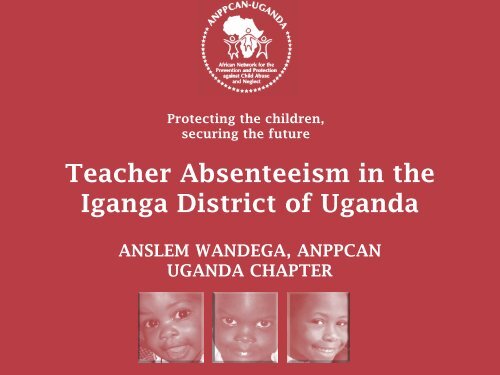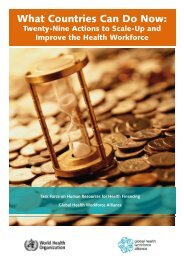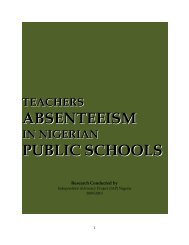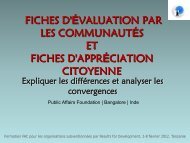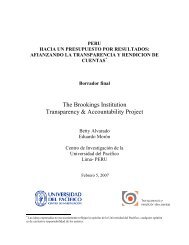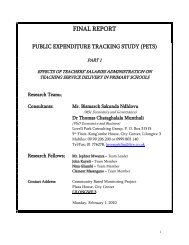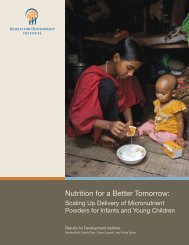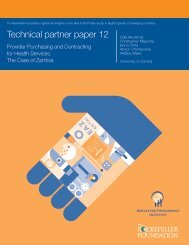ANPPCAN Presentation on Teacher Absenteeism - Transparency ...
ANPPCAN Presentation on Teacher Absenteeism - Transparency ...
ANPPCAN Presentation on Teacher Absenteeism - Transparency ...
You also want an ePaper? Increase the reach of your titles
YUMPU automatically turns print PDFs into web optimized ePapers that Google loves.
Protecting the children,<br />
securing the future<br />
<strong>Teacher</strong> <strong>Absenteeism</strong> in the<br />
Iganga District of Uganda<br />
ANSLEM WANDEGA, <str<strong>on</strong>g>ANPPCAN</str<strong>on</strong>g><br />
UGANDA CHAPTER
Introducti<strong>on</strong><br />
‣ <str<strong>on</strong>g>ANPPCAN</str<strong>on</strong>g> Uganda is a n<strong>on</strong>- government<br />
organizati<strong>on</strong> that is committed to addressing the<br />
problem of child abuse and neglect and<br />
promoting the rights of children. It is part of<br />
<str<strong>on</strong>g>ANPPCAN</str<strong>on</strong>g> Africa, a regi<strong>on</strong>al organizati<strong>on</strong> that<br />
seeks to protect and promote the rights of<br />
children in Africa. For over 16 years, <str<strong>on</strong>g>ANPPCAN</str<strong>on</strong>g><br />
Uganda has significantly c<strong>on</strong>tributed to raising<br />
public awareness <strong>on</strong> child rights and empowered<br />
both adults and children to seek redress when<br />
violati<strong>on</strong>s against children occur.<br />
Protecting the children,<br />
securing the future
Introducti<strong>on</strong> ct’d<br />
‣ One of <str<strong>on</strong>g>ANPPCAN</str<strong>on</strong>g>’s major interventi<strong>on</strong>s is to<br />
facilitate children’s access to their right to<br />
educati<strong>on</strong>.<br />
‣ <str<strong>on</strong>g>ANPPCAN</str<strong>on</strong>g> operates in 12 districts in Uganda<br />
including, Kampala and its envir<strong>on</strong>s, Muk<strong>on</strong>o,<br />
Jinja, Iganga, Kamuli, Busia, Kitgum, Pader, Apac,<br />
Arua, Rakai and Kasese.<br />
‣ <str<strong>on</strong>g>ANPPCAN</str<strong>on</strong>g> was supported by TAP to undertake the<br />
study <strong>on</strong> absenteeism in 30 educati<strong>on</strong> facilities<br />
in Iganga district, Eastern Uganda<br />
Protecting the children,<br />
securing the future
Background to<br />
UPE<br />
‣ Uganda is <strong>on</strong>e of the countries the world<br />
over that have pledged to meet the MDGs<br />
which aim at eradicating extreme poverty<br />
and improving the c<strong>on</strong>diti<strong>on</strong>s of the poor.<br />
As a member, Uganda therefore has to<br />
ensure universal primary educati<strong>on</strong> for all<br />
children by 2015.<br />
‣ In 1996, president Y.K Museveni<br />
announced that four children of school<br />
going age per family would benefit from<br />
Protecting the children,<br />
securing the future
Background ct’d<br />
from free primary educati<strong>on</strong>, starting<br />
from January 1997. This directive became<br />
a policy known as UPE. It was seen as the<br />
main tool for achieving the ec<strong>on</strong>omic,<br />
social and political objectives outlined in<br />
the Ugandan Ministry of Educati<strong>on</strong> and<br />
Sports policy document of 1998 in a<br />
decentralized framework. Broadly, the<br />
objectives of UPE are to:<br />
Protecting the children,<br />
securing the future
Background to<br />
UPE ctd<br />
o Establish, provide and maintain quality<br />
educati<strong>on</strong> as the basis for promoting human<br />
resource development;<br />
o Provide the facilities and resources to enable<br />
every child to enter and remain in school until<br />
the primary school cycle of educati<strong>on</strong> is<br />
complete;<br />
o Make basic educati<strong>on</strong> accessible to the learner<br />
and relevant to his or her needs, as well as<br />
meeting nati<strong>on</strong>al goals<br />
o Make educati<strong>on</strong> equitable in order to eliminate<br />
disparities and inequalities<br />
Protecting the children,<br />
securing the future
Background to<br />
UPE ctd<br />
o Ensure that educati<strong>on</strong> is affordable by the<br />
majority of Ugandans<br />
o Meet the objective of poverty eradicati<strong>on</strong> by<br />
equipping every individual with basic skills<br />
and knowledge.<br />
‣ When the implementati<strong>on</strong> of UPE started<br />
in 1997, the registrati<strong>on</strong> limit of 4<br />
children per family proved problematic,<br />
particularly regarding the exact definiti<strong>on</strong><br />
of a family in the Ugandan c<strong>on</strong>text.<br />
Eventually, the government removed this<br />
Protecting the children,<br />
securing the future
Background to<br />
UPE ctd<br />
restricti<strong>on</strong> and allowed all children that wanted<br />
primary educati<strong>on</strong> under the UPE program to<br />
enroll. Under the program, the government of<br />
Uganda abolished tuiti<strong>on</strong> fees and PTA charges<br />
for primary educati<strong>on</strong>.<br />
‣ To ensure access, the government instituted<br />
complementary financing measures. Financing of<br />
the educati<strong>on</strong> sector as a whole increased<br />
significantly, from 2.1% GDP in 1995 to 4.8% of<br />
GDP in 2000, while share of the educati<strong>on</strong> sector<br />
in the nati<strong>on</strong>al budget increased from 13.7% in<br />
1990 to 24.7% in 1998.In the financial year<br />
2005/6, government spent about 635.6bn Shs. <strong>on</strong><br />
Protecting the children,<br />
securing the future
Background to UPE<br />
ctd<br />
making it the sec<strong>on</strong>d largest funded sector<br />
in the country.<br />
‣ Uganda’s Educati<strong>on</strong> Sector Investment<br />
Plan also makes it mandatory that not less<br />
than 65% of the educati<strong>on</strong> budget must<br />
fund primary educati<strong>on</strong>.<br />
‣ UPE is also being implemented al<strong>on</strong>gside<br />
private school educati<strong>on</strong>, though the<br />
latter is c<strong>on</strong>centrated in the urban<br />
centers.<br />
Protecting the children,<br />
securing the future
UPE Background<br />
ct’d<br />
‣ Despite the aboliti<strong>on</strong> of tuiti<strong>on</strong> and PTA charges,<br />
primary educati<strong>on</strong> was not made entirely free,<br />
since parents were still expected to c<strong>on</strong>tribute<br />
exercise books, pens, uniform, bricks, and labour<br />
for classroom c<strong>on</strong>structi<strong>on</strong> through community<br />
work. During the implementati<strong>on</strong> stage however,<br />
the government realised that parents were not<br />
willing to c<strong>on</strong>tribute large amounts of bricks and<br />
labour, partly because of the many other<br />
demands <strong>on</strong> their time.<br />
‣ The government has since then provided m<strong>on</strong>ey<br />
for c<strong>on</strong>structi<strong>on</strong> of more classrooms, paying of<br />
Protecting the children,<br />
securing the future
Background to<br />
UPE ctd<br />
more teachers and purchase of requisite<br />
instructi<strong>on</strong>al materials, especially text books.<br />
‣ Stakeholders in the UPE Policy Implementati<strong>on</strong><br />
o The Ministry of Educati<strong>on</strong> and Sports<br />
o Local Authorities<br />
o School Management Committees<br />
‣ Progress<br />
o<br />
Strengths<br />
• Increased access to UPE from 3.1 milli<strong>on</strong> pupils<br />
in 1997-8.2 milli<strong>on</strong> pupils in 2009<br />
• Increase in the number of schools from 13, 576<br />
in 2005 to 14,179 in 2008<br />
Protecting the children,<br />
securing the future
Background to<br />
UPE ctd<br />
• Growth in the number of teachers with diplomas<br />
from 2,905 in 2007 to 5, 397 in 2008.<br />
• Three in every five pupils in lower have adequate<br />
sitting space<br />
• Literacy levels have increased to 69% at nati<strong>on</strong>al<br />
level<br />
‣ The number of teachers reduced by<br />
13.8% between 2007/8.<br />
‣ The teacher pupil ratio increased from<br />
1:50 in 2005 to 1:57 in 2008 as a result<br />
of streamlining the teachers’ ceiling<br />
Protecting the children,<br />
securing the future
Background to<br />
UPE ctd<br />
‣ The pupil completi<strong>on</strong> rate is still low. For<br />
example out of the 1,712,420 pupils who<br />
started P1 in 2002, <strong>on</strong>ly 516,890 pupils<br />
sat in 2008 and an average 450,000 in<br />
2007, representing <strong>on</strong>ly 27% and 26% of<br />
the children <strong>on</strong>ly.<br />
Protecting the children,<br />
securing the future
Objectives<br />
‣ Goal: To generate evidence to be used in<br />
an advocacy campaign aimed at curbing<br />
teacher absenteeism in public schools in<br />
Uganda<br />
‣ Specific Objectives<br />
o To document the magnitude of teacher<br />
absenteeism in UPE schools in Iganga district<br />
o To identify causes of teacher absenteeism in<br />
UPE schools in Iganga district<br />
o To establish a relati<strong>on</strong>ship between teacher<br />
Protecting the children,<br />
securing the future
Objectives ct’d<br />
absenteeism and pupil performance in UPE<br />
schools in the district<br />
o To identify existing initiatives to curb teacher<br />
absenteeism within the district<br />
o To identify and document best practices for<br />
countering teacher absenteeism for synergy<br />
and replicati<strong>on</strong> in other schools within the<br />
district<br />
Protecting the children,<br />
securing the future
Methodology<br />
‣ Study reached 620 people, i.e<br />
Commissi<strong>on</strong>er Pre-primary and Primary<br />
Educati<strong>on</strong>, Assistant Commissi<strong>on</strong>er<br />
Children and Youth Affairs, District<br />
Educati<strong>on</strong> Officer, Resident District<br />
Commissi<strong>on</strong>er, District Chairpers<strong>on</strong> of the<br />
Social Services Committee, District<br />
Inspectors of Schools, School heads or<br />
their deputies, parents, children,<br />
members of the SMCs, CSO<br />
representatives and community members.<br />
Protecting the children,<br />
securing the future
Methodology<br />
‣ Study was c<strong>on</strong>ducted in 30 purposively<br />
selected UPE schools located in 5 of the<br />
19 sub-counties of Iganga district<br />
‣ Schools were selected in a c<strong>on</strong>sultative<br />
meeting with the district leadership (LC V,<br />
RDC, CAO, DEO, DIS and District Planner)<br />
based <strong>on</strong> their poor record of<br />
performance in the Primary Leaving<br />
Examinati<strong>on</strong>s c<strong>on</strong>ducted between 2006<br />
and 2008<br />
Protecting the children,<br />
securing the future
Methodology<br />
‣ Document review<br />
o Sec<strong>on</strong>dary documents were reviewed<br />
• To assess trends and magnitude of teacher<br />
absenteeism within the selected schools<br />
• Identify best practices<br />
• Aid in the development of data collecti<strong>on</strong> tools<br />
‣ Key Informant interviews<br />
• Existing policies/guidelines <strong>on</strong> teacher absenteeism<br />
• Knowledge/c<strong>on</strong>cern about teacher absenteeism<br />
• Factors underlying teacher absenteeism<br />
• Strategies employed to curb the problem<br />
Protecting the children,<br />
securing the future
Methodology<br />
‣ Focus group discussi<strong>on</strong>s<br />
o These were held with children, parents and<br />
other community members to obtain<br />
informati<strong>on</strong> <strong>on</strong> teacher absenteeism in the<br />
schools in their areas.<br />
Protecting the children,<br />
securing the future
‣ Facility survey<br />
Methodology<br />
• Following the selecti<strong>on</strong> of the 30 educati<strong>on</strong> facilities,<br />
a letter from the Chief Administrative Officer copied<br />
to the Resident District Commissi<strong>on</strong>er was sent<br />
through the District Inspectors of schools to the<br />
respective schools heads and chairpers<strong>on</strong>s of the<br />
school management committees to come al<strong>on</strong>g with<br />
their school timetables for a c<strong>on</strong>sultative meeting<br />
with <str<strong>on</strong>g>ANPPCAN</str<strong>on</strong>g> officials in Iganga town<br />
• In a c<strong>on</strong>sultative meeting with school heads and<br />
chairpers<strong>on</strong>s of the school management committees<br />
from the 30 schools, official school timetables with<br />
names, dates, times and classes the respective<br />
classroom teachers were expected to teach were<br />
obtained by the study team to develop a register<br />
Protecting the children,<br />
securing the future
Methodology<br />
‣ Based <strong>on</strong> the register drawn, three un announced<br />
visits were made to each of the selected schools.<br />
During the visits, the enumerators met with the<br />
head teachers and where they were absent, their<br />
deputies or the teachers in charge to foremost up<br />
date the register given at the c<strong>on</strong>sultative meeting.<br />
‣ Head teachers or their representatives were then<br />
asked to go through the register to indicate whether<br />
the menti<strong>on</strong>ed teacher was present or not. If the<br />
head teacher or the representative indicated that a<br />
teacher was absent, he / she was further asked why<br />
that particular teacher was absent <strong>on</strong> that particular<br />
day.<br />
Protecting the children,<br />
securing the future
Methodology<br />
‣ After the interview with the either the head teacher<br />
or their representative was completed, the<br />
enumerators started interviewing teachers enlisted<br />
<strong>on</strong> the register, <strong>on</strong>e at a go to a minimum of six<br />
teachers per school (based <strong>on</strong> the total number of<br />
teachers employed at the school).<br />
‣ <strong>Teacher</strong>s’ records were also accessed from the head<br />
teachers to verify whether the reas<strong>on</strong>s given by<br />
particular teachers were actually those that<br />
appeared <strong>on</strong> the records in the head teachers’ or<br />
their representatives’ offices.<br />
‣ Visits were c<strong>on</strong>ducted between 8:30-4:00 pm,<br />
excluding break and lunch times<br />
Protecting the children,<br />
securing the future
Methodology<br />
‣ A teacher or head teacher was c<strong>on</strong>sidered to be<br />
absent when at the time of the un announced<br />
visit, he / she could not be physically seen in the<br />
school teaching a class she / he was supposed to<br />
be teaching as stipulated <strong>on</strong> the register and was<br />
away for reas<strong>on</strong>s given other than official leave,<br />
transfer, reassignment to teach a different class<br />
or do administrative tasks<br />
Protecting the children,<br />
securing the future
Background to<br />
Iganga district<br />
‣ It is located in the South Eastern part of<br />
Uganda. It borders Mayuge, Namutumba,<br />
Jinja and Kaliro.<br />
‣ It has 3 counties and 19 sub-counties, 115<br />
parishes and 644 villages<br />
‣ Has a populati<strong>on</strong> of 540,939 people.<br />
‣ Populati<strong>on</strong> growth rate is 3.4%, 0.2% above<br />
the nati<strong>on</strong>al average<br />
‣ There are 248 UPE schools<br />
‣ Has a shortfall of 100 teachers<br />
Protecting the children,<br />
securing the future
Iganga<br />
‣ Total enrollment is 132,858 pupils<br />
‣ On average, schools have under enrolled<br />
by 2,230 pupils<br />
‣ Some schools have over enrolled by over<br />
400 pupils.<br />
‣ 506 teachers are undergoing training<br />
‣ Between 2006 and 2009, 5,310 passed in<br />
first grade, 31,476 in sec<strong>on</strong>d grade,<br />
26,688 in third grade, 19,442 in fourth<br />
grade, 7268 in grade X (did not sit) and<br />
Protecting the children,<br />
securing the future
Iganga district<br />
27,768 failures in divisi<strong>on</strong> U. In other<br />
words, a total of 117,952 pupils who sat<br />
for exams between 2006-2009 in the<br />
district who failed to join a sec<strong>on</strong>dary<br />
school or any other instituti<strong>on</strong> of learning<br />
‣ 3.6% of the 70,266 pupils who failed in<br />
the country came from Iganga district.<br />
‣ Gross enrollment rate is 120 children<br />
‣ Net enrolment is 102<br />
‣ Gross intake is 120<br />
‣ Net intake is 59<br />
Protecting the children,<br />
securing the future
Iganga district<br />
‣ <strong>Teacher</strong> pupil ratio was 1: 63 in 2008<br />
‣ Pupil classroom ratio was 85:1 in 2008<br />
Protecting the children,<br />
securing the future
Magnitude<br />
A total, 561 teachers were registered to<br />
teach in the 30 schools<br />
Visit<br />
<strong>Absenteeism</strong> rates per visit<br />
Percentage<br />
First Visit 48.5<br />
Sec<strong>on</strong>d visit 46.5%<br />
Third visit 35.8%<br />
Average 43.6%<br />
Protecting the children,<br />
securing the future
Magnitude<br />
‣ 51% of the teachers absent were female<br />
compared to 49% male<br />
‣ Interviews with CSO’s and communities revealed<br />
that in a school of 6 teachers, 2 are absent for at<br />
least 3 days and the rest are either absent <strong>on</strong> the<br />
first or last days of the term or last days of the<br />
m<strong>on</strong>th or both<br />
Protecting the children,<br />
securing the future
Findings<br />
‣ Head teacher absenteeism<br />
Visit<br />
Percentage<br />
First Visit 30%<br />
Sec<strong>on</strong>d visit 20%<br />
Third visit 9%<br />
Average 19.7%<br />
Protecting the children,<br />
securing the future
Causes of teacher<br />
absenteeism<br />
‣ A total of 236 teachers were interviewed<br />
<strong>on</strong> what the causes were and findings<br />
were as follows:<br />
o 40.7% said that their colleagues absent<br />
themselves to engage in IGAs and supplement<br />
their incomes<br />
o 28.4% said that their colleagues absent<br />
themselves to attend to domestic problems<br />
o 19.9% said that their colleagues get absent<br />
because of transport problems<br />
o 10.6% said that their colleagues get absent to go<br />
and collect salaries<br />
Protecting the children,<br />
securing the future
Causes of teacher<br />
absenteeism<br />
‣ An interview with 30 head teacher or their<br />
representatives revealed the following:-<br />
o 33.3% of the teachers are absent due to sickness<br />
o 13.3% are absent because they are engaging in<br />
income generating activities<br />
o 6.7% are absent because they are doing farming<br />
especially during the rainy seas<strong>on</strong><br />
o 6.7% are absent because they are attending events<br />
such as marriage cerem<strong>on</strong>ies, funerals, etc<br />
o 3.3% are absent when they go to banks to<br />
withdraw their m<strong>on</strong>thly pay<br />
Protecting the children,<br />
securing the future
Causes of teacher<br />
absenteeism<br />
‣ 40% of the community members said that most<br />
teachers fake illnesses as they can actually be seen<br />
walking around in the village and doing their other<br />
work<br />
‣ 20% of the community members also said that most<br />
teachers are absent because of the distance from<br />
their homes to schools, especially during rainy<br />
seas<strong>on</strong><br />
‣ 10% of the community members also said that most<br />
teachers are absent because their head teachers are<br />
also absent<br />
‣ Others said that most teachers are absent because<br />
they have g<strong>on</strong>e to collect a salary in town<br />
Protecting the children,<br />
securing the future
Causes of teacher<br />
absenteeism<br />
‣ Inadequacies in inspecti<strong>on</strong> cause teacher<br />
absenteeism. <strong>Teacher</strong>s and head teachers with<br />
c<strong>on</strong>necti<strong>on</strong> to the top district officials had access<br />
to informati<strong>on</strong> <strong>on</strong> inspecti<strong>on</strong> dates and could<br />
choose to appear in school or inform others about<br />
the impending inspecti<strong>on</strong>. A total of 9,013 out of<br />
14,179 schools in the country were inspected at<br />
least <strong>on</strong>ce a term.<br />
‣ All resp<strong>on</strong>dents said that teacher absenteeism was<br />
partly to blame <strong>on</strong> low teacher pay. As a matter of<br />
fact, most (35.2%) of those interviewed said that<br />
they were living with more than 6 people in their<br />
homes and 41.9% said that they are the sole bread<br />
winners in their homes.<br />
Protecting the children,<br />
securing the future
Causes of teacher<br />
absenteeism<br />
‣ Transport was found to be a cause of teacher<br />
absenteeism. 48.3% of the teachers interviewed<br />
reside between 2-5 kilometers away from the school,<br />
27.5% reside some 5 kms away from the school<br />
while 23.7% reside less than 2 kilometers from the<br />
school. Accommodati<strong>on</strong> had been given to <strong>on</strong>ly 8.9%<br />
of the teachers who were involved in the study with<br />
the rest either renting or coming from their own<br />
homes<br />
‣ In terms of hours of travel to school, most (19.6%) of<br />
the teachers said that they travel for more than 5<br />
hours to school, 7.6% for more than 4 hours, 12.3%<br />
between 2-4 hours and 17.8% between 1-2 hours and<br />
the rest for less than 1 hour<br />
Protecting the children,<br />
securing the future
Causes of teacher<br />
absenteeism<br />
‣ Weak disciplinary measures taken against<br />
absentee teachers are also partly<br />
resp<strong>on</strong>sible for teacher absenteeism.<br />
16.7% of the head teachers interviewed<br />
said that they advice teachers who are<br />
absent not to do it again, 80% give them a<br />
warning letter while 3.3% report them to<br />
the school management committees.<br />
Protecting the children,<br />
securing the future
<strong>Teacher</strong><br />
absenteeism and<br />
pupil performance<br />
‣ To establish this relati<strong>on</strong>ship, records were<br />
reviewed, teachers and head teachers who had<br />
been at the school for more than three years were<br />
asked to comment <strong>on</strong> the trends of teacher<br />
absenteeism and how these have affected pupil<br />
performance in their respective schools.<br />
‣ <strong>Teacher</strong>s said that they had been absent from the<br />
school at least <strong>on</strong>ce since they were recruited for<br />
<strong>on</strong>e reas<strong>on</strong> or the other.<br />
‣ 6.7% of the head teachers said that teacher<br />
absenteeism has been very often been occurring in<br />
their schools in the past 5 years, 3.3% said that it<br />
has often been occurring in their school 86.7% said<br />
that it has<br />
Protecting the children,<br />
securing the future
<strong>Teacher</strong><br />
absenteeism and<br />
pupil performance<br />
been rarely occurring in the past 5 years in their<br />
schools and 3.3% said that it has been very rarely<br />
occurring in their schools in the past five years.<br />
‣ 40% of the head teachers said that the quality of<br />
teaching and learning had improved in their<br />
schools, 46.7% said that it had slightly improved,<br />
10% said that it has remained the same and 3.3%<br />
said that it had become worse.<br />
‣ 80% of the children interviewed said that their<br />
grades became low when their teachers were<br />
absent because of n<strong>on</strong> completi<strong>on</strong> of the<br />
syllabus.<br />
Protecting the children,<br />
securing the future
<strong>Teacher</strong><br />
absenteeism and<br />
pupil performance<br />
‣ Between 2007 and 2009, 2,122 pupils had sat for<br />
PLE and 65 had passed in first grade, 1084 in<br />
sec<strong>on</strong>d grade, 166 in third grade, 673 in fourth<br />
grade, 69 in divisi<strong>on</strong> X and 65 in Divisi<strong>on</strong> U.<br />
‣ <strong>Teacher</strong> absenteeism was found to be partly<br />
resp<strong>on</strong>sible for poor pupil academic performance<br />
in the selected schools<br />
Protecting the children,<br />
securing the future
Existing<br />
initiatives to curb<br />
absenteeism<br />
‣ Use of school inspecti<strong>on</strong>s. 37% of the<br />
schools had been inspected within the<br />
m<strong>on</strong>th of the visit, 23.3% six m<strong>on</strong>ths<br />
before, 13.3% a year before the visit.<br />
‣ Head teacher supervisi<strong>on</strong>. 50% of the head<br />
teachers observe classes <strong>on</strong>ce in a week,<br />
6.7% twice in a week, 20% thrice a week<br />
and 23.3% every day.<br />
‣ Use of school registers. This was being<br />
practices in very few schools<br />
Protecting the children,<br />
securing the future
Best practices<br />
‣ The following are the approaches being<br />
used to reduce teacher absenteeism<br />
• Introduced school registers (63.3%)<br />
• Changed school administrati<strong>on</strong> (3.3%)<br />
• Encouraged community involvement (3.3%)<br />
• Recruited highly qualified staff (3.3%)<br />
• Increased inspecti<strong>on</strong> visits (3.3%)<br />
• Parents cooperati<strong>on</strong> (3.3%)<br />
• Introduced allowances for teachers (3.3%)<br />
• Increased supervisi<strong>on</strong> at school level by SMCs and<br />
head teachers (3.3%)<br />
• Elected a new SMC (6.7%)<br />
Protecting the children,<br />
securing the future
Recommendati<strong>on</strong>s<br />
‣ Strengthen inspecti<strong>on</strong>. Inspectorate departments<br />
at nati<strong>on</strong>al and district level should be<br />
strengthened with more man power and finances.<br />
Inspecti<strong>on</strong>s are ideally supposed to be abrupt but<br />
in some instances, before the inspector reached a<br />
school, informati<strong>on</strong> <strong>on</strong> the visit had been already<br />
leaked to the teachers and they would rush to<br />
attend to their classes. A heavy penalty to punish<br />
those who share such sensitive informati<strong>on</strong> should<br />
be clearly spelt out and enforced<br />
‣ Strengthen local accountability mechanisms.<br />
Head teachers should increase the times they<br />
m<strong>on</strong>itor classes to at least twice in a week and<br />
should also be checking for absenteeism<br />
Protecting the children,<br />
securing the future
Recommendati<strong>on</strong>s<br />
‣ There is need for str<strong>on</strong>g SMCs since where they<br />
were str<strong>on</strong>g, absenteeism was low due to c<strong>on</strong>stant<br />
m<strong>on</strong>itoring<br />
‣ Punish n<strong>on</strong> compliant school heads. There is need<br />
for str<strong>on</strong>ger penalties for head teachers who do not<br />
effectively supervise their staff.<br />
‣ <strong>Teacher</strong> transfers. <strong>Teacher</strong>s who stay at the school<br />
for 20 years should be transferred. Young head<br />
teachers fear to punish such teachers because they<br />
have served for l<strong>on</strong>g and understand all the<br />
dynamics in that school.<br />
Protecting the children,<br />
securing the future
Recommendati<strong>on</strong>s<br />
‣ Empower children and communities to<br />
m<strong>on</strong>itor teacher absenteeism<br />
‣ Provide accommodati<strong>on</strong> for teachers at<br />
the schools.<br />
‣ Provide meals for teachers.<br />
‣ Ensure timely distributi<strong>on</strong> of instructi<strong>on</strong>al<br />
materials<br />
‣ Increase salaries for teachers in rural<br />
areas.<br />
Protecting the children,<br />
securing the future
Recommendati<strong>on</strong>s<br />
‣ Leaves. It was found out that some teachers were<br />
out of the school because they were sick. There is a<br />
need for school administrators to ensure that<br />
teachers who go are absent because they are sick<br />
submit proof of medical treatment from a<br />
recognized health instituti<strong>on</strong> up<strong>on</strong> return. This will<br />
discourage faking of “sickness” by teachers as<br />
reported by the communities.<br />
‣ District officials should engage private sector<br />
providers to extend banking services to teachers<br />
in rural areas.<br />
‣ Appoint teachers and head teachers <strong>on</strong> c<strong>on</strong>tract<br />
Protecting the children,<br />
securing the future
Way Forward<br />
‣ Meeting to validate and disseminate<br />
findings at district level (targeting<br />
District Political and Technical Staff<br />
c<strong>on</strong>cerned with educati<strong>on</strong> service<br />
delivery, Head <strong>Teacher</strong>s, <strong>Teacher</strong>s, SMC’s,<br />
Children, <strong>Teacher</strong>s’ Uni<strong>on</strong>s, CSO’s, etc<br />
‣ Public Dialogue <strong>on</strong> <strong>Teacher</strong><br />
<strong>Absenteeism</strong> at nati<strong>on</strong>al level: To<br />
disseminate findings at nati<strong>on</strong>al level but<br />
also engage key actors (Parliamentary<br />
Social Services Committee Members,<br />
Protecting the children,<br />
securing the future
Way Forward<br />
Parliamentary Budget Committee<br />
Members, Uganda Parliamentary<br />
Committee for Children, Primary<br />
Educati<strong>on</strong>, Ministry of Finance, Planning<br />
and Ec<strong>on</strong>omic Development, Minister of<br />
Educati<strong>on</strong> and Sports, State Minister for<br />
Primary Educati<strong>on</strong>, Commissi<strong>on</strong>er and<br />
Directors for Pre-Primary and Primary<br />
Educati<strong>on</strong>, Educati<strong>on</strong> Funding Group<br />
(EFAG) Members, Media, CSO’s and UN<br />
Protecting the children,<br />
securing the future
Way Forward<br />
Agencies <strong>on</strong> teacher absenteeism in<br />
Iganga district and Uganda as a country<br />
‣ Follow up meetings with the key issues<br />
identified during engagements both at<br />
local and nati<strong>on</strong>al levels (As an<br />
organizati<strong>on</strong> but also through established<br />
coaliti<strong>on</strong>s-EFAG, FENU, UNICEF Educati<strong>on</strong><br />
Sub-cluster)<br />
‣ Multi-media campaign with messages <strong>on</strong><br />
teacher absenteeism(Press c<strong>on</strong>ferences,<br />
Protecting the children,<br />
securing the future
Way Forward<br />
posters, T-shirts, Caps, Radio and TV talk<br />
shows and spots, News and Opini<strong>on</strong><br />
Articles in the Leading Newspapers<br />
Organize DAC Celebrati<strong>on</strong>s with a focus<br />
<strong>on</strong> teacher absenteeism in Iganga district<br />
‣ Produce and disseminate 500 copies of<br />
the report to educati<strong>on</strong> officials at district<br />
and nati<strong>on</strong>al level and also higher<br />
instituti<strong>on</strong>s of learning<br />
‣ Effectively participate in the Educati<strong>on</strong><br />
Protecting the children,<br />
securing the future
Way Forward<br />
Sector Review meeting for 2010-2011 to<br />
profile issues that appeared in the report<br />
‣ Train and support 30 children and 10<br />
focal teachers to m<strong>on</strong>itor levels of<br />
absenteeism in 10 of the selected 30<br />
schools<br />
Protecting the children,<br />
securing the future
THANK YOU<br />
Protecting the children,<br />
securing the future


